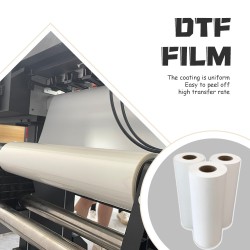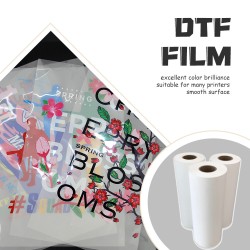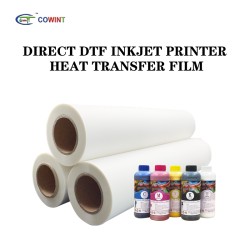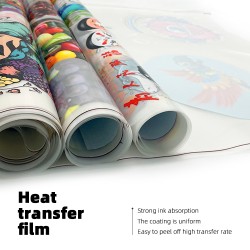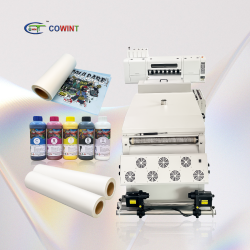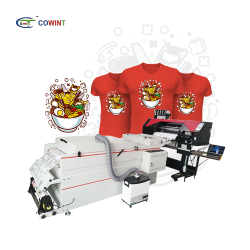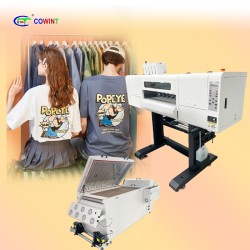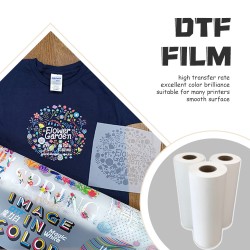1. The problem of sticky hands after printing glue
After the printing paste is printed and dried, there is a sticky phenomenon, which becomes more serious with the increase of temperature.
Reason: The main raw material of printing glue is acrylic resin, which is determined by the characteristics of the resin. If a harder resin is used, the problem of stickiness can be solved, but the adhesion force decreases very seriously. If the adhesion force is increased, a softer resin must be selected. , but the soft resin is easy to stick back.
Solution: Use the printing glue release agent produced by Dongguan Aoda Chemical Co., Ltd., add it into the printing glue and mix it evenly. After printing, the printing glue release agent can form a film on the surface, which does not affect the printing glue. The adhesion of the pulp also solves the problem of sticky hands.
2. The solution to the phenomenon of plugging in the flat screen fabric printing
Reasons: The density of the original sheet is not enough; the flat screen plate making operation process is improper; the quality of the printing paste is wrong.
Solution:
The manuscripts are currently produced by computer. The higher the black density, the better the shading effect of the graphic pattern of the negative. If the blackness is not enough, the shading effect will be worse, and the ultraviolet light will easily pass through, which will cause the mesh; the haze of the negative should be low. Completed, it is easy to cause excessive exposure time and cause blocking.
Improper development and curing process of flat screen plate making will lead to jamming. When developing, it should be taken into account that the ultraviolet light is transmitted from the printing surface of the screen to the squeegee surface, the printing surface is fully illuminated, and can be rinsed with high-pressure water; and the degree of cross-linking of the squeegee surface is smaller than that of the printing surface, and the adhesive film is not visible. When rinsing, it should be rinsed with the residual slurry of non-pressure water slurry to avoid the residual slurry from clogging the mesh. Before curing, a second exposure should be carried out to make the adhesive layer fully photosensitive and then apply the curing agent.
When printing, the slurry used contains impurities or undissolved particles that block the mesh, so that the color paste cannot be scraped out of the mesh during printing, so the slurry should be filtered to remove impurities before use. When making the coating adhesive, choose a good quality adhesive and a thickener with good compatibility, and the conjunctiva should not be too fast when scratching.
3. The process of generating pattern edges from clear to fuzzy
At the beginning of printing, because the fluidity of the slurry is good, the squeegee does not need a lot of force to cut the slurry clean. With the continuous evaporation of the water in the glue, the slurry gradually thickens and the viscosity becomes larger. It is necessary to increase the particle size of the squeegee to cut off the excess slurry. Due to the increase in strength, the elastic deformation of the screen produces pattern displacement. With the disappearance of the force of the squeegee, the edge of the pattern on the screen printing surface will stick to the paste after the screen rebounds. During the second printing, These pastes migrate to the edges of the pattern, resulting in blurring of the pattern edges.
Solution:
(1) Use wire mesh with small elasticity, such as polyester wire mesh;
(2) Increase the tension of the wire mesh;
(3) Reduce the resilience of the wire mesh;
(4) Adjust the viscosity of the slurry at any time.
4. The reasons for the sharp corners of the pattern to become rounded and the loss of small dots
Since the slurry gradually thickens during the printing process, its fluidity becomes smaller. When passing through the mesh, the pressure of the squeegee must be increased to pass through the mesh. However, at the edge of the screen pattern, due to the cushioning effect of the photosensitive adhesive, the The squeegee cannot squeeze the slurry out of the mesh at any time, so that the slurry particles stay in the mesh to form a film, causing the mesh on the edge of the photosensitive adhesive to block.
Solution:
(1) Use low mesh, monofilament and thin wire mesh;
(2) The photosensitive glue should not be too thick;
(3) The slurry should maintain a certain fluidity at all times.
5. Reasons for the skinning phenomenon of glue in the printing process
Any printing material has a common characteristic, that is: the thinner the ink layer, the faster the drying, and the same is true for the glue. Since the screen is larger than the pattern, there is enough space for the paste in the screen to be stacked, and it is impossible for the squeegee to clean the paste every time it is printed. Especially, a thinner ink layer is often generated above the pattern. The ink layer will form a semi-dry film in a short period of time, and these films are brought into the partial holes by the squeegee to block the mesh holes, resulting in local blockage.
Solution:
Use wooden strips to isolate the pattern area of the screen from the screen frame to control the slurry within a certain range. The squeegee can clean the slurry on the edge of the screen pattern every time, which means that the slurry is within this range. It is impossible to produce a thin layer of ink inside, so that the phenomenon of skinning can be eliminated.
6. The paint color paste prepared by yourself has seepage phenomenon, why? How to solve?
Self-prepared paint pastes are water-based pastes for textile printing. Infiltration (bleeding) can be found from the following aspects.
a. Synthetic fiber fabrics: such as polyester, nylon, polypropylene, etc., or blends with a high proportion of synthetic fibers. Synthetic fiber: The fabric is a hydrophobic substance, and the water-based slurry of the coating used for printing cotton fabrics is easy to permeate and smear. When printing synthetic fabrics, thick emulsified paste should be used when mixing the pulp to avoid dilution with water. If it must be diluted, it should be diluted with a thin emulsified paste. Do not dilute directly with water.
b. If the humidity in the air is too high, such as long-term rainy weather in the south, less or no water should be added when mixing pulp.
c. Cotton fabric is a natural cellulose fiber fabric, which is a hydrophilic substance. Generally not easy to permeate. However, if the capillary effect is too high, it will also lead to osmosis. Therefore, the appropriate capillary effect is controlled at about 7-8cm. Before feeding, it is crucial to ask the manufacturer's technical indicators. If the capillary effect is too low, it will not be printed, and if the capillary effect is too high, it will cause permeation.
d. Some enterprises use emulsified paste as thickener, commonly known as A-gang paste. It is emulsified with white kerosene, peregrine and synthetic dragon glue under high-speed stirring. If the A-gang pulp has quality problems and is not fully emulsified, there will be "oil circles" after printing, which will easily cause misunderstandings of "bleeding" or "watermarks".
Therefore, good quality A-gang pulp should be used or a synthetic thickener should be used to overcome the occurrence of "oil ring".
e. There are many comprehensive factors that cause "seepage" and "bleeding", such as the weave structure is too thin, too thin, and too light; the pattern area is too large; the mesh number is too low; the pressure during operation is too large; The type does not correspond, the amount of sizing is too large and so on.
In addition, the countertop also has a lot to do with it. If you use glass or plastic veneer with a very smooth hard surface, it will also cause seepage of the pallet. The outline is not clear, but should be changed to a flexible soft countertop.
7. How to mix pastes of different colors?
Color science is a deep knowledge, and color matching requires the accumulation of practice. Learn the theory well, be brave in practice, the splendid and colorful will belong to you. A good colorist seems to be able to roughly determine the basic formula of color matching. There are also some old color grading technicians. When the mass production is about to come out, they find problems and add color materials in time. It is too late to make samples. Basic skills.
First, from the three basic colors of red, yellow, and blue, the secondary colors are called out: orange, green, and purple. Then modulate three colors: yellow gray, blue gray, red gray.
Then, take each single color in each set of chromatograms from light color to medium color to dark color, and the dosage is 0.1%, 0.5%, 1%, 3%, 5%, and scratch and print the formula for the sample sticker.
In addition, each batch of business samples and formulas should be kept on file for reference. Perseverance will surely yield results.
The general principles of color grading are as follows:
Minimize the number of dyes or paints used in color matching. One can be used, but two, and two can be used, but three. In order to facilitate the control of color and light, generally three or less color matching is better. The second is the same type of dyes or coatings. It is best not to mix different brands of different manufacturers. If it is necessary to use the "coloring head", then the "coloring head" can only be very small, and the two brands cannot be equally divided.
Another principle is: dyes or paints have their saturation values, and if they exceed their saturation values, they are easy to wash off and cause contamination. Even if the paint is black, the dosage should be controlled at 8%-10%, not more than 10%.
8. How to choose and use elastic overprint glue to ensure its color fastness?
a. If it is clothing, choose water-based elastic overprint glue. Because clothing printing is required to be odorless and soft to the touch, especially the printing of export clothing or high-end products is particularly strict.
b. The type of fabric has an extremely important relationship with the color fastness of the elastic overprint paste. The elastic overprint glue used for cotton fabrics should not be used on synthetic fibers, because the color fastness cannot be guaranteed, and special glue for polyester or nylon should be selected.
c. Rainproof nylon or polyester, used as banners, parasols, etc., the outdoor environment requires good weather fastness, and should withstand the sun and rain. Solvent-based inks can be selected when the smell and soft hand feel are not too demanding. , such as polyester ink, nylon ink to print. For coated fabrics, it is better to select the corresponding ink according to the coating material.
d. Due to the different materials and production processes of various manufacturers, to understand the use method, please read the manual carefully. Some products require drying at 130-150℃ for 3-5min to increase color fastness. And many individual workers tend to focus on printing quality, ignoring the post-processing process. The process of baking is omitted, resulting in a situation where it will fall off after a wash, and all previous efforts will be abandoned.
Even low-temperature "glue" or paint paste cannot be washed after printing. It should be fully dried for 24h, preferably placed for 7 days, so that the color fastness can reach the highest value. If it is dried at about 100 ℃, it is better to iron it with an iron.
Thermosetting ink printing
9. Why does thermosetting ink printing do not block the screen and can print wet to wet?
This is the biggest question of the traditional textile and garment printing industry. They were amazed when they saw the high-speed production of the fully automatic garment printing machine (one piece every five seconds); when they saw the thermoset ink printing without cleaning the screen, the next day or even ten days and a month later, the printing could be continued. It's incredible. why? Because everyone thinks that the printing paint must contain an adhesive, and the adhesive must be sticky (so it will stick to the plate when it is still wet) and self-curing (of course, it will block the screen).
10. Is thermosetting ink (English: PLASTISOLINK) a textile printing coating?
of course! But it is a new type of printing paint, that is, printing paint without any binder. Therefore, the thermosetting ink does not have the viscosity and self-curing properties of the adhesive, and it also has the conditions of never blocking the screen and non-sticking the screen.
Having the conditions of non-stick screen does not mean absolutely non-stick screen, because thermosetting ink is a paste after all. In order to achieve wet-to-wet high-speed printing, it is also necessary to master the technology of thermosetting ink dot printing.
From this, we know that textile printing coatings have been divided into two categories: adhesive and non-adhesive. Thermosetting ink is a non-adhesive textile printing coating, and its accurate name should be: hot melt curing PVC textile printing coating.
 +8615820889696
+8615820889696 Info@cowint.com
Info@cowint.com



